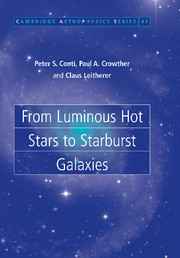Book contents
- Frontmatter
- Contents
- Preface
- Acknowledgements
- 1 Introduction
- 2 Observed properties
- 3 Stellar atmospheres
- 4 Stellar winds
- 5 Evolution of single stars
- 6 Binaries
- 7 Birth of massive stars and star clusters
- 8 The interstellar environment
- 9 From giant HII regions to HII galaxies
- 10 Starburst phenomena
- 11 Cosmological implications
- References
- Acronyms
- Symbols
- Object index
- Subject index
1 - Introduction
Published online by Cambridge University Press: 28 October 2009
- Frontmatter
- Contents
- Preface
- Acknowledgements
- 1 Introduction
- 2 Observed properties
- 3 Stellar atmospheres
- 4 Stellar winds
- 5 Evolution of single stars
- 6 Binaries
- 7 Birth of massive stars and star clusters
- 8 The interstellar environment
- 9 From giant HII regions to HII galaxies
- 10 Starburst phenomena
- 11 Cosmological implications
- References
- Acronyms
- Symbols
- Object index
- Subject index
Summary
Motivation
The aim of this book is to describe the connection between the physics and evolution of relatively nearby luminous hot stars and more distant starburst phenomena occurring all the way to cosmological distances. There have been recent significant advances in our knowledge concerning hot stars and their contribution to highly energetic star formation episodes. The Hubble Space Telescope (HST) and Spitzer in particular have provided many new insights into these areas. Recent observations of the near infrared regions have also greatly aided our view of star formation processes. This book is aimed at those extragalactic astronomers who would be interested in hot star astrophysics and those stellar astrophysicists concerned with galaxy evolution. It would be of use in graduate astrophysics courses at a level suitable for advanced students. This monograph will be one of the first of its kind in spanning the connection from the astrophysics of hot stars to that of newly forming galaxies.
Observed properties
The Hertzsprung–Russell diagram
What are stars? They are fully gaseous, ionized, gravitationally bound entities, emitting large amounts of radiation over many wavelengths. In normal stars, the gas is in hydrostatic pressure equilibrium under the ideal gas law equation of state. It is held in balance against the inward forces of gravity by the outward pressure of radiation generated from nuclear reactions in the stellar interior (or from gravitational contraction adjustments).
- Type
- Chapter
- Information
- From Luminous Hot Stars to Starburst Galaxies , pp. 1 - 16Publisher: Cambridge University PressPrint publication year: 2008

